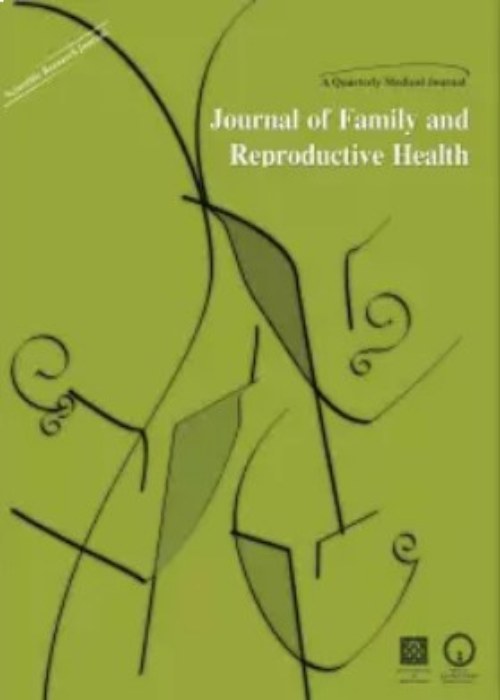فهرست مطالب
Journal of Family and Reproductive Health
Volume:2 Issue: 4, Dec 2008
- تاریخ انتشار: 1388/10/11
- تعداد عناوین: 6
-
Page 167ObjectiveTo determine the effects of three-month regular aerobic exercise on the PMS symptoms. Also correlations with age, education, marital status and severity of PMS symptoms were studied.Materials And MethodsA Quasi- Experimental study was conducted on 91 volunteer women with regular menstrual cycle and no history of gynecological, endocrinological and psychological disorders. The study was done during March 2005- March 2007, in Tehran University of Medical Sciences. A Modified Menstrual Distress Questionnaire (MMDQ) was used in this study. Participants were divided into two groups: Non-exercised, they also didnt have any past experience of regular exercise (n= 48) and Exercised (n= 43). The exercise time duration was one hour and was carried out three times per week for three months. Emotional, behavioral, electrolyte, autonomic, neurovegatative and skin symptoms of PMS were compared between two groups. P value was considered significant at < 0.05.ResultsA significant difference was observed for electrolytic, neurovegetative and cognitive symptoms before and after the exercise. Also the severity of skin and neurovegetative symptoms were different in experimental groups with and without past history of doing regular exercise. There was no correlation between age, education, marital status and severity of PMS symptoms.ConclusionThree months of regular aerobic exercise effectively reduces the severity of PMS symptoms.
-
Page 173ObjectiveThe aim of this study was to investigate the relation between overweight and obesity among adolescent students and age of menarche.Materials And MethodsIn a cross-sectional study 399 urban adolescent girls aged 11-14 years old were selected from schools of Kermanshah city in Iran. Anthropometric examinations including, triceps skin fold (TSF), mid arm circumference (MAC), body fat percentage (BF %), were measured and information on age of menarch and student’s demographics were collected.ResultsThe results showed that age, body mass index (BMI) and menarche age were:12.63+1.01 year, 17.71+2.94 kg/m2 and 12.16+1.18 year respectively. Prevalence of overweight in respondents was 23.2%, however; prevalence of obesity was 23.2% for 11 years old, 22.4% for12 years olds, 24% of 13 years old and 23.5% of 14 years old.ConclusionThere was a reverse relation between BMI and age of menarche, however; it was not significant (p>0.1). This study suggests a high prevalence of obesity and relation between BMI and anthropometric parameters in adolesent girls.
-
Comparison of Fluconazole and Clotrimazole in the Treatment of Acute Candida Albicans VulvovaginitisPage 179ObjectiveThis study compared two antifungal drugs, fluconazole and clotrimazole for the treatment of vulvo vaginal candidiasis.Materials And MethodsThis randomized clinical trial was conducted on 120 women with vulvo vaginal candidiasis during a six month period. All patients answered a standard questionnaire containing questions about symptoms of vulvovaginal candidiasis and presence of vaginal discharge and signs of vulvar and vaginal inflammation were documented according to physical examination. Two swabs of vaginal discharge were obtained for each woman, one for direct smear, another for culture. The culture medium was Sabouraud Dextrose Agar (SDA). Patients were randomized into two groups of clotrimazole (vaginal cream for 7 days and 150 mg fluconazole in a single dose. Clinical and paraclinical responses were calculated.ResultsClinical improvement occurred in 96 cases (80%). This value was 86.7% and 73.3%for clotrimazole and fluconazole, respectively (P-value=0.04). Paraclinical response on tenth day of treatment was observed in 87 patients (72.5%). This value was 66.7% and 78.3%for clotrimazole and fluconazole groups, respectively (P-value=0.110). Mean days of treatment was 4.06 ±1.30 days for clotrimazole and 2.70 ±0.78 days for fluconazole (p value =0.031).ConclusionMost of the clinical and paraclinical responses to the drugs used for the treatment of vulvo vaginal candidiasis are in the favour of fluconazole.
-
Page 185ObjectiveWe aimed to evaluate the influence of drug dependency on sexual function of wives of opium addicts.Materials And MethodsIn a cross-sectional study, 150 wives of opiate dependent men were assessed for the impact of drug addiction. Sociodemographic factors like age, educational level, job, marital duration and having child were evaluated. Sexual function was measured using relationship and sexuality scale (RSS).ResultsApproximately 73% of the participitants were sexually active with having at least one intercourse in the last 2 weeks, and approximately half of the participitants had unsatisfied intercourse. About ninety percent reported negative effect of the addiction on their sexual life. After the spouse addiction, sexual desire, ability to reach orgasm and frequency of sexual intercourse were decreased in 73%, 64% and 67.3%, respectively.ConclusionThe wives of opiate addicts believe that their sexual function has been impaired by the addiction of their husbands.
-
Page 191ObjectiveThis study aimed to determinate the relationship between neonatal birth weight and related factors in Jahrom, Iran.Materials And MethodsAll women delivering in two hospitals, in which obstetric services were presented, entered the study. In this cross sectional study, 2311 women were enrolled prospectively in a 12- month period during 2006-7. Data were collected during first three post partum days from the following sources: maternal hospital files and charts, interview with the mothers, measurement of anthropometric indices of fathers and the infants. Percentile distribution of birth weight for classified gestational age was calculated.ResultsResults showed significant correlation between neonatal birth weight with neonatal gender, maternal age, weight, education and working status. There was no relation between neonatal weight with paternal weight, maternal education and living in urban or rural areas.ConclusionNeonatal birth weight is affected by neonatal gender, maternal age and weight; education and job.
-
Page 195Aortic aneurysm is a rare but potentially lethal complication during pregnancy. In this article we described a 30-year-old woman with a large size descending aorta aneurysm (11 cm in length and 5.6 cm in its greatest diameter), who had two term uncomplicated pregnancies. The patient received prophylactic ß-blocker drug during her second pregnancy. Both pregnancies were terminated by caesarean section without any serious complications. Postpartum period was recovered successfully, but a noticeable increase in aneurysm’s length was detected in the period between two pregnancies.


